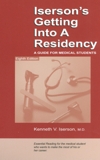|
Links:
 Iserson's
Getting Into a Residency: A Guide for Medical Students, 8th Edition Iserson's
Getting Into a Residency: A Guide for Medical Students, 8th Edition
 Rèsumès
and Personal Statements for Health Professionals, 2nd Rèsumès
and Personal Statements for Health Professionals, 2nd
 Non-Standard
Medical Electives in the U.S. and Canada
Non-Standard
Medical Electives in the U.S. and Canada
SPECIALTY
SELECTION & RESIDENCY PROGRAM
SELECTION & APPLICATION PROCESS
The
following outline, from Iserson's Getting Into a Residency, Fifth
Edition, outlines the process from start to finish. The book describes
each step in detail. Use this form as a checklist as you move toward
your goal of obtaining the perfect specialty and residency match
for you!
If
you don't know where you are going, you won't know when you get
there. -Anonymous
Basic
Science Years
[] Find and work with a mentor.
[] Volunteer for clinical experiences.
[] Begin research, if applicable.
[] For specialties that interest you:
Meet
with specialists in your local area.
Read journals and "throwaway" magazines.
Write to specialty organizations for information.
Attend local specialty society meetings.
[]
Prepare for the USMLE/COMLEX examination.
Clinical
Years
[] Do well on clinical rotations:
Identify
clerkship expectations in advance.
Read assignments.
Read about your patients' diseases and procedures
Round early; stay late.
Prepare for small-group sessions.
Study for tests.
Request reference letters (written, not sent yet).
[]
Reevaluate specialty choice.
[] Gather more information about specialties of interest.
[] Take Glaxo Welcome Pathway Evaluation Program.
[] Do a subinternship that gives you responsibility.
[] Prepare for USMLE/COMLEX examination.
Once
You Select a Specialty
[] Set up filing system for information.
[] Gather information about residency programs:
Use
FREIDA.
Review the "Green Book" or Osteopathic listings.
Write for individual programs' information.
Work with specialist outside your medical center.
Do elective in the specialty.
[]
Complete your master "Must/Want" Analysis form.
[] Join local and national specialty society.
[] Find out if specialty uses special match or special application
procedures (Electronic Residency Application Service, Central Application
Service).
Application
Process
[] Set up system to track each program's application needs.
[] Apply to NRMP or specialty's Matching Program.
[] Have your photograph taken.
[] Arrange your Dean's interview.
[] Review your medical school transcript.
[] Arrange to send transcripts and reference letters to programs.
[] Complete applications and send them to programs. Arrange to have
Deans letters sent to programs. Buy interview attire.
[] Do "mock" interview.
[] Update residency program information.
[] Call programs to arrange interview schedule.
Interviewing
[] Know the interview schedule. .
[] Arrive early.
[] Allow extra time at program.
[] Review material about program.
[] Talk with current residents.
[] Know your questions.
[] Smile!
After
You Visit Programs
[] Send thank-you letters.
[] Send any additional requested information.
[] Complete "Must/Want" Analysis Form for that program.
[] Rank programs using "Must/Want" Analysis Forms.
[] Submit Rank-Order List to matching program.
If
You Don't Match
[] Don't panic!
[] Contact programs with available positions. Send materials by
fax or e-mail. Contract them via phone or e-mail.
When
You Match
[] Call program director.
[] Send information to program about how to contact you until July
1.
[] Relax! Congratulations!
©2000-2001,
Galen Press, Ltd., Tucson, AZ
|
 EXTRAS
EXTRAS
 Iserson's
Getting Into a Residency: A Guide for Medical Students, 8th Edition
Iserson's
Getting Into a Residency: A Guide for Medical Students, 8th Edition Rèsumès
and Personal Statements for Health Professionals, 2nd
Rèsumès
and Personal Statements for Health Professionals, 2nd 